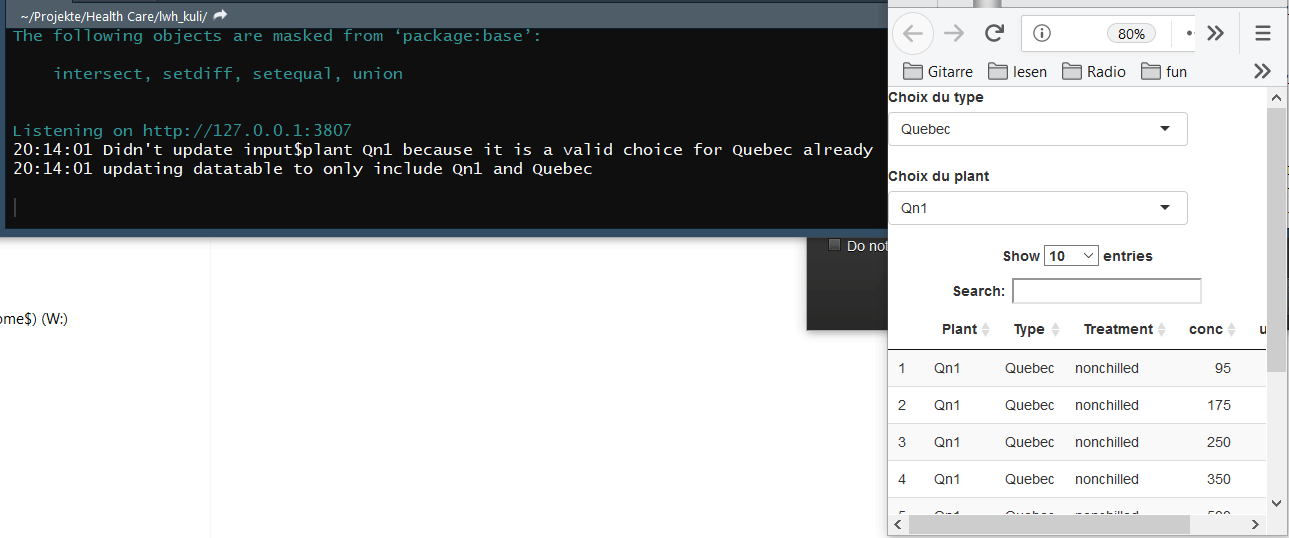иҫ“е…Ҙзӣёдә’дҫқиө–ж—¶пјҢеҰӮдҪ•йҳІжӯўиҫ“еҮәиҝҗиЎҢдёӨж¬Ўпјҹ
жҲ‘жӯЈеңЁејҖеҸ‘дёҖдёӘеҹәдәҺR Shinyзҡ„еә”з”ЁзЁӢеәҸгҖӮ жҲ‘жғіи®©жҲ‘зҡ„иҫ“е…ҘдёҺеҸҜз”Ёж•°жҚ®дҝқжҢҒдёҖиҮҙпјҢеӣ жӯӨжҲ‘жӣҙж–°дәҶselectInputдёӯзҡ„йҖүе®ҡеҖјгҖӮ еҪ“жҲ‘жӣҙж”№иҫ“е…Ҙ1дёӯзҡ„йҖүе®ҡеҖјж—¶пјҢе°Ҷжӣҙж–°иҫ“е…Ҙ2зҡ„еҖјпјҢ然еҗҺжӣҙж–°ж•°жҚ®пјҲд»…дёҖж¬ЎпјүгҖӮеҘҪ дҪҶжҳҜпјҢеҰӮжһңжҲ‘жӣҙж”№иҫ“е…Ҙ2дёӯзҡ„йҖүе®ҡеҖјпјҢеҲҷжӣҙж–°ж•°жҚ®пјҢ然еҗҺжӣҙж–°иҫ“е…Ҙ1зҡ„еҖјпјҢ然еҗҺеҶҚж¬Ўжӣҙж–°ж•°жҚ®гҖӮ зӯҫеҮәжү“еҚ°дёӨж¬Ўзҡ„вҖң check Latest_valueвҖқгҖӮ
жңҖеҲқпјҢжҲ‘дҪҝз”ЁrenderUIиҖҢдёҚжҳҜupdateSelectInputпјҢдҪҶжҳҜеңЁеҲқе§ӢеҢ–ж—¶пјҢж•°жҚ®иў«и®Ўз®—дёӨж¬ЎгҖӮ
library(shiny)
library(DT)
library(dplyr)
my_data=data.frame(CO2)
# Running a Shiny app object
app <- shinyApp(
ui = bootstrapPage(
selectInput('type','Choix du type',choices = unique(my_data$Type)),
uiOutput('plant_ui'),
DTOutput('plot')
),
server = function(input, output) {
data=reactive({
# req(input$type)
my_data_temp=my_data
if(length(input$type)>0){
my_data_temp=my_data_temp%>%filter(Type%in%input$type)
}
if(length(input$plant)>0){
my_data_temp=my_data_temp%>%filter(Plant%in%input$plant)
}
my_data_temp
})
latest_plant_value=reactive({
if(is.null(input$plant))data()$Plant[1]
else input$plant
})
output$plant_ui=renderUI({
sub_data=data()
selectInput(inputId = 'plant',"filtre par plant",choices = unique(sub_data$Plant),
selected=latest_plant_value())
})
output$plot <- renderDT({
print("check latest_value")
datatable(data()) })
}
)
runApp(app)
иҝҷе°ұжҳҜдёәд»Җд№ҲжҲ‘еҶіе®ҡеҹәдәҺжӯӨAlternate control of a sliderInput between a derived value and user selected valueдҪҝз”ЁupdateSelectInputзҡ„еҺҹеӣ пјҢдҪҶжҳҜд»Јз Ғзҡ„йЎәеәҸз»“жһ„дҪҝжҲ‘еңЁжӣҙж”№иҫ“е…Ҙ2зҡ„еҖјж—¶и®Ўз®—дёӨж¬Ўж•°жҚ®гҖӮ
library(shiny)
library(DT)
library(dplyr)
my_data=data.frame(CO2)
# Running a Shiny app object
app <- shinyApp(
ui = bootstrapPage(
selectInput('type','Choix du type',choices = unique(my_data$Type),selected=my_data$Type[1]),
selectInput('plant','Choix du type',choices = unique(my_data$Plant),selected=my_data$Plant[1]),
DTOutput('plot')
),
server = function(input, output,session) {
data=reactive({
# req(input$type)
my_data_temp=my_data
if(length(input$type)>0){
my_data_temp=my_data_temp%>%filter(Type%in%input$type)
}
if(length(input$plant)>0){
my_data_temp=my_data_temp%>%filter(Plant%in%input$plant)
}
my_data_temp
})
observeEvent(input$type,{
print("update type changed")
updateSelectInput(session, "plant",
selected = unique(my_data%>%filter(Type%in%input$type)%>%.$Plant)[1])
})
observeEvent(input$plant,{
print("update plant changed")
updateSelectInput(session, "type",
selected = unique(my_data%>%filter(Plant%in%input$plant)%>%.$Type)[1])
})
output$plot <- renderDT({
print("check latest_value")
datatable(data()) })
}
)
runApp(app)
иҝҷз§Қи§ЈеҶіж–№жі•еңЁйӮЈз§Қжғ…еҶөдёӢдёҚиө·дҪңз”ЁпјҢеӣ дёәжҲ‘жІЎжңүе°қиҜ•е®һзҺ°еҗҢдёҖ件дәӢthree interdependent selectInput in R/Shiny application
жҲ‘еёҢжңӣжҜҸдёӘиҫ“е…Ҙзҡ„й»ҳи®ӨйҖүе®ҡеҖјдҝқжҢҒдёҖиҮҙпјҢд»ҘдҫҝиҝҮж»ӨеҷЁиҮіе°‘иҝ”еӣһ1дёӘеҖјгҖӮжҲ‘жӣҙж”№зҡ„жүҖжңүиҫ“е…ҘеҶ…е®№гҖӮ
2 дёӘзӯ”жЎҲ:
зӯ”жЎҲ 0 :(еҫ—еҲҶпјҡ1)
и§ЈеҶіжӯӨй—®йўҳзҡ„дёҖз§Қж–№жі•жҳҜеҲӣе»әдёҖдёӘreactiveValпјҢйҖҡзҹҘеә”з”ЁзЁӢеәҸжӯЈеңЁиҝӣиЎҢжӣҙж–°ж“ҚдҪңпјҢ并иҰҒжұӮdataзӯүеҫ…иҜҘж Үеҝ—иҝ”еӣһFalseжүҚиғҪиҝҗиЎҢгҖӮ
жҲ‘е·ІеңЁжӮЁзҡ„第дәҢдёӘй—Әдә®еә”з”ЁзЁӢеәҸдёӯж·»еҠ дәҶ5иЎҢпјҡ
иҮҙserver()пјҡ
# Create update in progress flag
updating_type_inprogress <- reactiveVal(FALSE)
иҮҙobserveEvent(input$type ...пјҡ
# When type is changed, set flag to TRUE
updating_type_inprogress(TRUE)
иҮҙobserveEvent(input$plant ...пјҡ
# Once this function has run, the updating operation is done
updating_type_inprogress(FALSE)
иҮҙdata()пјҡ
# Stops updating data() if the in-progress flag is TRUE
req(!updating_type_inprogress())
иҮҙrenderDT()пјҡ
# Stops updating renderDT() if the in-progress flag is TRUE
# this is probably optional unless there's resource-intensive code
# that doesn't depend on changes in data()
req(!updating_type_inprogress())
иҝҷжҳҜж•ҙдёӘд»Јз Ғпјҡ
library(shiny)
library(DT)
library(dplyr)
my_data=data.frame(CO2)
# Running a Shiny app object
app <- shinyApp(
ui = bootstrapPage(
selectInput('type','Choix du type',choices = unique(my_data$Type),selected=my_data$Type[1]),
selectInput('plant','Choix du type',choices = unique(my_data$Plant),selected=my_data$Plant[1]),
DTOutput('plot')
),
server = function(input, output,session) {
data=reactive({
req(!updating_type_inprogress())
print(input$type)
print(input$plant)
my_data_temp=my_data
if(length(input$type)>0){
my_data_temp=my_data_temp%>%filter(Type%in%input$type)
}
if(length(input$plant)>0){
my_data_temp=my_data_temp%>%filter(Plant%in%input$plant)
}
my_data_temp
})
observeEvent(input$type,{
updating_type_inprogress(TRUE)
updateSelectInput(session, "plant",
selected = unique(my_data%>%filter(Type%in%input$type)%>%.$Plant)[1])
})
observeEvent(input$plant,{
updating_type_inprogress(FALSE)
updateSelectInput(session, "type",
selected = unique(my_data%>%filter(Plant%in%input$plant)%>%.$Type)[1])
})
updating_type_inprogress <- reactiveVal(FALSE)
output$plot <- renderDT({
req(!updating_type_inprogress())
print("check latest_value")
datatable(data()) })
}
)
runApp(app)
еҰӮжӮЁжүҖи§ҒпјҢжӣҙж”№input$typeж—¶пјҢdata()е’ҢrenderDT()еҮҪж•°д»…дҪҝз”ЁжӯЈзЎ®жӣҙж–°зҡ„еҖјиҝҗиЎҢдёҖж¬Ўпјҡ
[1] "check latest_value"
[1] "Quebec"
[1] "Qn1"
[1] "check latest_value"
[1] "Mississippi"
[1] "Mn1"
[1] "check latest_value"
[1] "Quebec"
[1] "Qn1"
зӯ”жЎҲ 1 :(еҫ—еҲҶпјҡ1)
жңүи¶Јзҡ„й—®йўҳпјҢдёҚе®№жҳ“и§ЈеҶіпјҒжңүи¶Јзҡ„жҳҜпјҢжӮЁжүҖиҰҒзҡ„дёҚжҳҜжӮЁжүҖйңҖиҰҒзҡ„гҖӮи§ӮеҜҹпјҡ
- еҰӮжһңеңЁInput1дёәвҖңеҜҶиҘҝиҘҝжҜ”е·һвҖқж—¶з”ЁжҲ·йҖүжӢ©дәҶ Qn2 пјҢеҲҷйҰ–е…ҲеңЁ Quebec дёҠи®ҫзҪ®Input1пјҢ然еҗҺеңЁдёҠи®ҫзҪ® hard set Input2 > Qn1 пјҢжӣҙж”№з”ЁжҲ·зҡ„йҖүжӢ©гҖӮдёҚеҘҪгҖӮ
- дёҖж—ҰдёӨдёӘиҫ“е…Ҙдёӯзҡ„д»»дҪ•дёҖдёӘжӣҙж”№пјҢж•°жҚ®иЎЁжҖ»жҳҜжӣҙж–°пјҢеӣ жӯӨеҜ№иҜҘиЎЁиҝӣиЎҢдәҶи®ёеӨҡйҮҚж–°и®Ўз®—гҖӮ
еӣ жӯӨпјҢи§ЈеҶіж–№жЎҲжҳҜеҸҢйҮҚзҡ„пјҡ
- иҜ·еӢҝиҰҶзӣ–з”ЁжҲ·зҡ„йҖүжӢ©пјҢдҫӢеҰӮ Qc2 еҲ° Qc1 гҖӮжҲ‘дёәжӯӨдҪҝз”ЁдәҶ if жқЎд»¶гҖӮ
- е®үиЈ… watchguard д»…жӣҙж–° е®һйҷ…жӣҙж”№е…¶еҶ…е®№ж—¶зҡ„ж•°жҚ®иЎЁгҖӮжҲ‘дҪҝз”Ё reactiveValпјҲпјүиҝӣиЎҢжӯӨж“ҚдҪңпјҢд»…еңЁдёӨдёӘиҫ“е…Ҙзҡ„йҖүжӢ©жңүж•Ҳж—¶пјҲеҚіпјҢз»“жһңйӣҶеӨ§дәҺ0ж—¶пјүжӣҙж–°гҖӮ
иҜ·еҸӮйҳ…дёӢйқўзҡ„з»“жһңгҖӮи§ӮзңӢжҺ§еҲ¶еҸ°иҫ“еҮәд»Ҙи§ӮеҜҹеҶізӯ–гҖӮ
library(shiny)
library(DT)
library(dplyr)
my_data=data.frame(CO2)
shinyApp(
ui = bootstrapPage(
selectInput('type','Choix du type',choices = unique(my_data$Type),selected=my_data$Type[1]),
selectInput('plant','Choix du plant',choices = unique(my_data$Plant),selected=my_data$Plant[1]),
DTOutput('plot')
),
server = function(input, output,session) {
latest_data <- reactiveVal(my_data)
observe({
result <- my_data %>% filter(Type %in% input$type, Plant %in% input$plant)
if(nrow(result) > 0){
latest_data(result)
}else{
cat(format(Sys.time(), "%H:%M:%S"), "Didn't update the dataframe because the choice was not valid.\n")
}
})
observeEvent(input$type,{
if(! input$plant %in% my_data$Plant[my_data$Type == input$type]){
old <- input$plant
new <- my_data %>% filter(Type %in% input$type) %>% slice(1) %>% pull(Plant) %>% as.character()
updateSelectInput(session, "plant", selected = new)
cat(format(Sys.time(), "%H:%M:%S"), "Updated input$plant from", old, "to", new, "so that it represents a valid choice for", input$type, "\n")
}else{
cat(format(Sys.time(), "%H:%M:%S"), "Didn't update input$plant", input$plant, "because it is a valid choice for", input$type, "already\n")
}
})
observeEvent(input$plant,{
updateSelectInput(session, "type",
selected = my_data %>% filter(Plant %in% input$plant) %>% slice(1) %>% pull(Type))
})
output$plot <- renderDT({
cat(format(Sys.time(), "%H:%M:%S"), "updating datatable to only include", isolate(input$plant), "and", isolate(input$type), "\n\n")
latest_data()
datatable(latest_data())
})
}
)
- йҳ»жӯўеҮҪж•°иҝҗиЎҢдёӨж¬Ў
- йҳІжӯў`performSelectorInBackgroundпјҡ`иҝҗиЎҢдёӨж¬Ўпјҹ
- жҸ’е…Ҙ3дёӘзӣёдә’дҫқиө–зҡ„иЎЁ
- йҳІжӯўи®Ўж—¶еҷЁиҝҗиЎҢдёӨж¬Ў
- еңЁиҝҗиЎҢзӣёе…ід»»еҠЎд№ӢеүҚжЈҖжҹҘиҫ“е…Ҙ
- йҳІжӯўjunitжөӢиҜ•иҝҗиЎҢдёӨж¬Ў
- еҰӮдҪ•йҳІжӯўSAPUI5з”ҹе‘Ҫе‘ЁжңҹиҝҗиЎҢдёӨж¬Ўпјҹ
- еҰӮдҪ•йҳІжӯўжҢҮд»ӨжҺ§еҲ¶еҷЁиҝҗиЎҢдёӨж¬Ў
- еҰӮдҪ•йҳІжӯўи¶…ж—¶еҠҹиғҪиҝҗиЎҢдёӨж¬Ў
- иҫ“е…Ҙзӣёдә’дҫқиө–ж—¶пјҢеҰӮдҪ•йҳІжӯўиҫ“еҮәиҝҗиЎҢдёӨж¬Ўпјҹ
- жҲ‘еҶҷдәҶиҝҷж®өд»Јз ҒпјҢдҪҶжҲ‘ж— жі•зҗҶи§ЈжҲ‘зҡ„й”ҷиҜҜ
- жҲ‘ж— жі•д»ҺдёҖдёӘд»Јз Ғе®һдҫӢзҡ„еҲ—иЎЁдёӯеҲ йҷӨ None еҖјпјҢдҪҶжҲ‘еҸҜд»ҘеңЁеҸҰдёҖдёӘе®һдҫӢдёӯгҖӮдёәд»Җд№Ҳе®ғйҖӮз”ЁдәҺдёҖдёӘз»ҶеҲҶеёӮеңәиҖҢдёҚйҖӮз”ЁдәҺеҸҰдёҖдёӘз»ҶеҲҶеёӮеңәпјҹ
- жҳҜеҗҰжңүеҸҜиғҪдҪҝ loadstring дёҚеҸҜиғҪзӯүдәҺжү“еҚ°пјҹеҚўйҳҝ
- javaдёӯзҡ„random.expovariate()
- Appscript йҖҡиҝҮдјҡи®®еңЁ Google ж—ҘеҺҶдёӯеҸ‘йҖҒз”өеӯҗйӮ®д»¶е’ҢеҲӣе»әжҙ»еҠЁ
- дёәд»Җд№ҲжҲ‘зҡ„ Onclick з®ӯеӨҙеҠҹиғҪеңЁ React дёӯдёҚиө·дҪңз”Ёпјҹ
- еңЁжӯӨд»Јз ҒдёӯжҳҜеҗҰжңүдҪҝз”ЁвҖңthisвҖқзҡ„жӣҝд»Јж–№жі•пјҹ
- еңЁ SQL Server е’Ң PostgreSQL дёҠжҹҘиҜўпјҢжҲ‘еҰӮдҪ•д»Һ第дёҖдёӘиЎЁиҺ·еҫ—第дәҢдёӘиЎЁзҡ„еҸҜи§ҶеҢ–
- жҜҸеҚғдёӘж•°еӯ—еҫ—еҲ°
- жӣҙж–°дәҶеҹҺеёӮиҫ№з•Ң KML ж–Ү件зҡ„жқҘжәҗпјҹ
